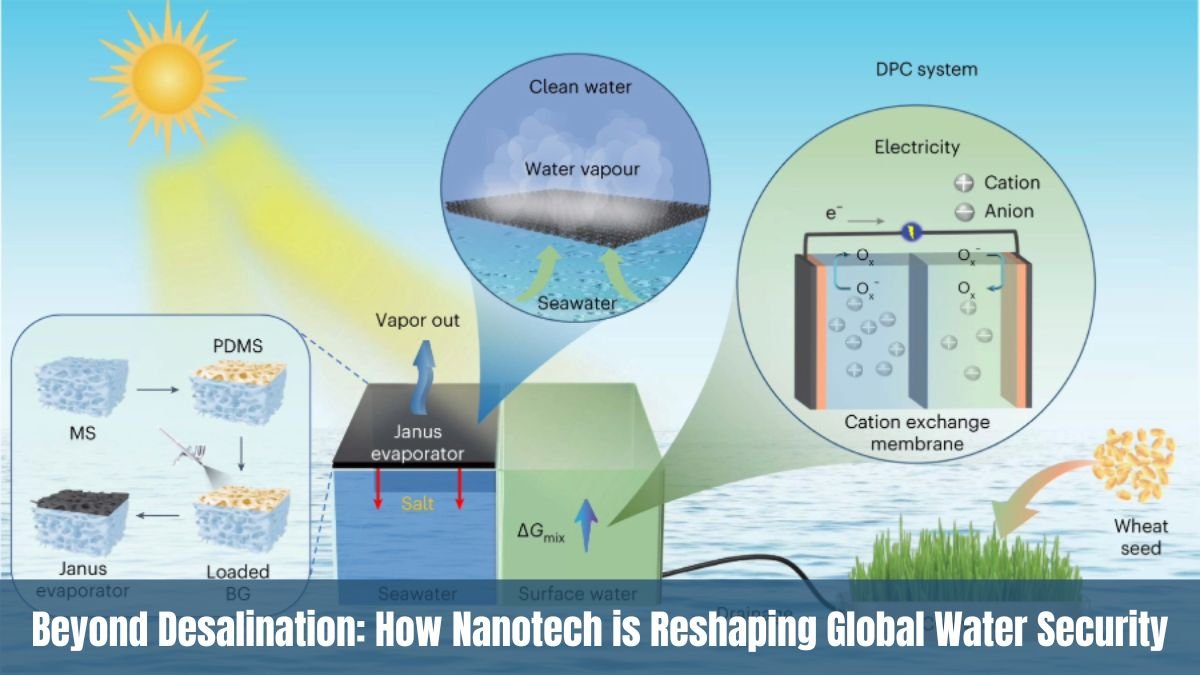Introduction: Water is the basis of human life. It is impossible to imagine life without water. But the way population, urbanization and industrialization have increased rapidly in the 21st century, water scarcity has become a serious global crisis. Nanotech The United Nations report shows that about 40% of the world’s population is already facing water crisis, and if steps are not taken, this crisis can become even more terrible in the coming years.
So far, desalination (making sea water into fresh water) has been considered a major option to deal with the water crisis. But this process is energy-intensive and expensive. Here a revolutionary branch of modern science – nanotechnology – is opening a new way to water security. Nano-level technologies are not only making desalination more economical and energy-conserving, but are also changing the entire structure of water purification and distribution.
Desalination and its limitations
Desalination, that is, making salty sea water drinkable, is a lifeline for many countries today. Especially in the Middle East and Gulf countries, more than 50% of drinking water comes from desalination plants.
But its challenges are also big:
- This process is very expensive.
- It consumes a lot of energy.
- After this, the disposal of the remaining salty waste (brine) harms the environment.
- This is why scientists were looking for new technologies and nanotechnology has opened up amazing possibilities in this direction.
Nanotechnology: Game-changer in water security
Nanotechnology means controlling matter at a very small level (one nanometer i.e. one billionth of a meter). At this level, the physical and chemical properties of the matter change, and they can be used in new ways.
The most important contribution of nanotechnology in the water sector is nano-membrane filtration and nano-material based water purification.
Nano-membranes
These are extremely thin and strong membranes with pores so small that salt molecules and harmful pollutants can be easily trapped. Compared to conventional membranes, they are:
- more durable,
- consume less energy,
- and provide more pure water at a lower cost.
Purification with nano-particles
Substances such as carbon nanotubes, graphene oxide and silver nanoparticles can remove toxic metals, bacteria and even viruses from water. This technology is proving to be a boon for areas where availability of clean water is a dream.
Impact of nanotech on global water security
Now the question is that nanotechnology is not limited to desalination only, but how is it changing global water security?
Making water accessible to all: In many rural areas of Africa and Asia, availability of water is the biggest challenge. Nanotechnology-based small and portable water filters are now providing safe drinking water to people in these areas.
Energy efficiency: While traditional desalination requires huge energy, nano-membranes can operate at low pressure and low energy. This reduces the cost of water production and also reduces the burden on the environment.
Industrial waste management: Wastewater from factories and industrial units causes large-scale pollution. This water can also be purified and reused with nanotechnology-based filtration technology.
Disaster management: During earthquakes, floods or other natural disasters, there is a huge shortage of clean water. Nano-filters and nano-kits are helpful in providing immediate relief in such situations.
Future direction: Nanotech + AI + IoT
- The future of water security does not depend only on nanotechnology, but technologies like artificial intelligence (AI) and Internet of Things (IoT) are also getting added to it.
- With the help of AI, it can be predicted which area will face water crisis and need a solution.
- IoT sensors can continuously monitor water quality and share data instantly.
- By connecting nano-membranes to smart systems, a fully automated water purification network can be created.
India and nanotech water solutions
In a country like India, where on one hand there are huge rivers but on the other hand the problem of clean drinking water persists, nanotechnology can become a big source of solution. Portable nano-filters in rural areas, desalination plants in urban areas and nano-waste management technology in industrial areas can improve both water availability and quality in the coming years.
Challenges and precautions
- Although nanotechnology sounds magical, it also has some risks:
- The impact of long-term use of nano-particles on the environment is not fully known yet.
- The initial cost and research investment in implementing these technologies on a large scale is high.
- Regulations and standards are not yet clear.
Therefore, it is important that governments, scientists and industry work together to formulate a responsible and sustainable policy so that the maximum benefits of nanotechnology reach society.
Conclusion
Water scarcity is no longer just an environmental issue, but a question of global security and survival. Nanotechnology, along with traditional technologies, gives us a new hope – a hope in which every human being can get safe and clean water.
Beyond desalination, nano-membranes and nano-particles are changing the entire picture of water availability, purification and distribution. If investments and support are made in the right direction, nanotechnology can prove to be the biggest solution to the global water crisis in the future.
